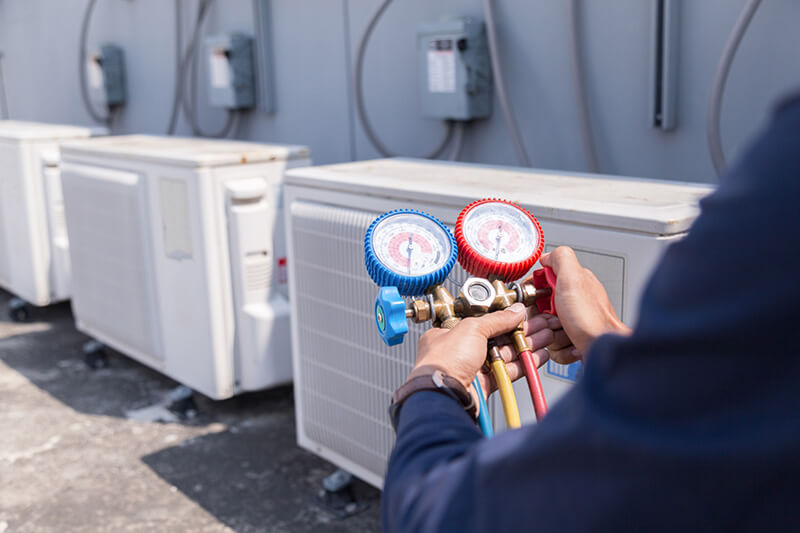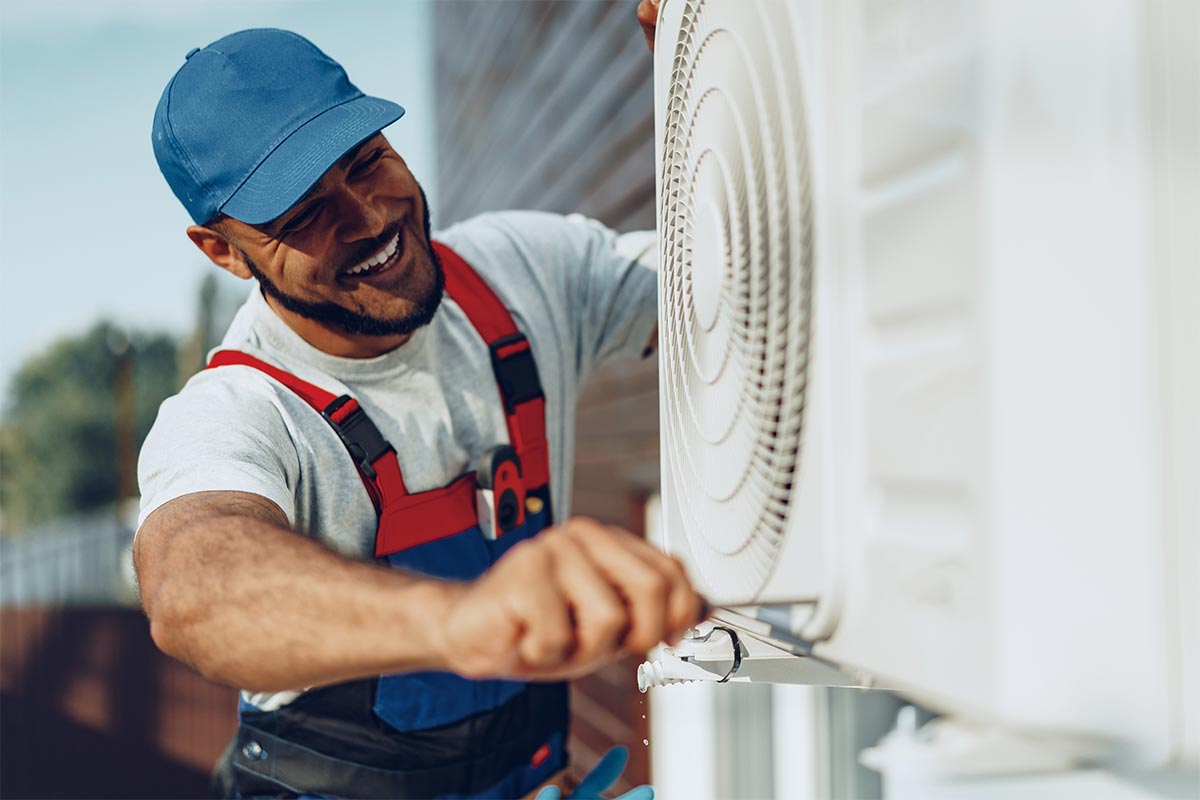Exactly How a Heatpump and Heater Interact to Maximize Your Home's Home heating Effectiveness
Recognizing just how a heatpump and heating system interact is vital for house owners looking for effective home heating options. Each system has its toughness, giving a well balanced strategy to home convenience. The heatpump masters modest temperatures, while the heating system supplies rapid warmth during severe cold. This synergy not only reduces power expenses however also boosts the life-span of both home appliances. What elements influence this cooperation, and exactly how can house owners maximize their advantages?
Comprehending Heat Pumps: Just How They Work
Several individuals might be unknown with their inner functions, heat pumps play a crucial function in modern-day heating systems. These tools operate by moving heat from one place to another, using the concepts of thermodynamics. In colder months, a warmth pump extracts warm from the outdoors air, ground, or water, and transfers it indoors to warm up the living space. On the other hand, during warmer months, it can reverse the procedure, serving as an air conditioner by getting rid of heat from inside to the outside.Heat pumps contain an evaporator, condenser, growth, and compressor valve. The refrigerant within the system takes in warmth as it vaporizes at low temperatures and pressures. The compressor then boosts the stress and temperature level of the refrigerant, allowing it to release warm as it condenses. This effective procedure can significantly decrease energy usage contrasted to typical home heating approaches, making heat pumps a sustainable choice for climate control in homes.
The Function of Heating Systems in Home Home Heating
Furnaces play an important function in home heating by giving a reputable resource of warmth during the colder months. They operate by generating heat through combustion or electric resistance, dispersing it throughout the home by means of air ducts or glowing systems. The efficiency of a furnace is typically determined by its Annual Gas Use Effectiveness (AFUE) score, which suggests how efficiently the unit converts gas into heat.Furnaces can utilize various power resources, including natural gas, oil, electrical energy, or propane, permitting house owners to select the most ideal choice for their demands. Unlike warm pumps, which may battle in extreme cool, heating systems maintain regular performance, guaranteeing that interior temperatures remain comfy no matter exterior problems. Additionally, modern heaters commonly come geared up with innovative innovation, such as wise thermostats and variable-speed blowers, boosting their effectiveness and responsiveness. This flexibility makes heaters a vital component in all-inclusive home heating approaches.

Benefits of Making Use Of Both Solutions With Each Other
Integrating the strengths of both heating systems and heat pumps can bring about a much more reliable and reliable home heating solution. Using both systems allows house owners to make the most of the warm pump's power efficiency during milder temperature levels while counting on the heating system for even more extreme cold conditions. This twin method can greatly minimize power costs, as warmth pumps consume less electrical energy than traditional heating techniques when temperature levels are moderate.Additionally, using both systems with each other can boost comfort levels in the home. Heatpump can supply regular, even heating, while heating systems can swiftly elevate ambient temperature levels when needed. The combination of both systems can prolong the life expectancy of devices by minimizing wear and tear on each device, as they share the work. Eventually, home owners can enjoy a balanced, economical heating remedy that readjusts perfectly to varying weather problems, ensuring a cozy and welcoming home throughout the winter season.
Exactly How Heat Pumps and Furnaces Complement Each Other
When homeowners incorporate heat pumps and furnaces, they produce a corresponding heater that takes full advantage of performance and comfort. Heatpump operate by moving heat from the outdoors air or ground, making them highly effective in moderate climates. They stand out throughout milder temperature levels, offering affordable home heating. Alternatively, furnaces create heat via combustion or electrical resistance, providing solid, instant heat during severe cold conditions.The combination of these 2 systems enables for vibrant adjustments based upon temperature level changes. Throughout warmer months or milder winter months days, the warm pump can take the lead, saving energy and lowering costs. As temperature levels drop, the heating system can seamlessly engage, making certain consistent heat throughout the home. This harmony not only optimizes energy usage yet also improves the life-span of both systems, as each device runs within its optimal efficiency range. Together, they produce a balanced atmosphere that adjusts to differing environment demands.
Optimizing Effectiveness: Tips for Homeowners
House owners can boost their heating effectiveness via numerous sensible strategies. Establishing a regular maintenance schedule, integrating smart thermostat technology, and implementing effective insulation and sealing solutions are key steps. These measures not just boost convenience yet additionally visit this web-site minimize energy costs.
Routine Upkeep Schedule
To guarantee optimal home heating performance, developing a routine maintenance schedule is vital for any type of home. Property owners ought to prioritize regular examinations of both heatpump and heating systems to establish peak performance. This consists of transforming air filters every one to 3 months, as clogged up filters can substantially minimize efficiency. In addition, organizing expert upkeep at the very least resource when a year allows professionals to determine and deal with possible problems before they rise. House owners ought to also cleanse the warm pump's outdoor device to avoid particles accumulation that can hinder air flow. By adhering to a routine maintenance routine, property owners not just enhance their heater' efficiency yet also expand their lifespan, bring about better comfort and reduced power costs throughout the chillier months.
Smart Thermostat Assimilation
Incorporating a smart thermostat into a home heating system can significantly improve energy performance, especially as it permits precise control over temperature setups. These tools can find out the home owner's timetable and choices, immediately changing the temperature to optimize convenience while decreasing power use. They can reduce home heating throughout times when the home is vacant, decreasing unnecessary intake. Lots of smart thermostats also give real-time power usage information, allowing property owners to make enlightened choices regarding their heating behaviors. Furthermore, remote access using mobile phone apps permits users to readjust settings from anywhere, making sure the home is cozy upon return. On the whole, wise thermostat integration not just improves convenience but substantially contributes to power savings and performance.
Insulation and Sealing Solutions
Smart thermostats play a crucial function in power efficiency, yet their effectiveness can be considerably enhanced by appropriate insulation and securing options. Property owners should prioritize shielding attics, walls, and floorings to minimize heat loss. Top notch insulation products, such as spray foam or fiberglass, can greatly enhance thermal resistance. Furthermore, securing gaps around ducts, windows, and doors prevents cold air infiltration and heat escape. Weatherstripping and caulking work approaches for dealing with these leaks - heat pump installation ooltewah tn. Regular evaluations for air leaks, along with using blower door tests, can help identify problem areas. By spending in insulation and securing, home owners can maximize the efficiency of their home heating systems, eventually causing minimized energy usage and lower energy costs
Typical Myths About Heat Pumps and Furnaces
What misconceptions border heatpump and heating systems? Numerous individuals mistakenly think that heatpump are inefficient in colder environments. Actually, contemporary heat pumps are made to run efficiently also in reduced temperatures, giving reliable home heating throughout wintertime. Another usual myth is that furnaces are constantly much more reliable than heatpump. This depends on the details energy resources and performance scores of the devices in concern. Some might likewise assume that utilizing both systems simultaneously is unneeded, yet actually, this mix can optimize home heating effectiveness, especially throughout extreme weather. Additionally, people often presume that warmth pumps require continuous upkeep, when in truth, they have similar upkeep requires to traditional furnace. By disproving these myths, property owners can make even more enlightened decisions regarding news their heating options, eventually bring about improved comfort and energy effectiveness in their homes.
Upkeep Factors To Consider for Combined Equipments

Regularly Asked Inquiries
Can Warm Pumps Work Effectively in Extremely Cold Climates?
Heatpump can battle in very chilly climates because of reduced performance and warm extraction limitations. Advancements in innovation have led to designs designed for far better performance in such problems, boosting their practicality in harsh settings.
The Length Of Time Do Warmth Pumps and Furnaces Usually Last?
Heatpump normally last 15 to 20 years, while heating systems have a life-span of 15 to thirty years. Normal maintenance can prolong their long life, guaranteeing reliable procedure and decreasing the demand for premature replacements.

What Is the Ordinary Expense of Installing Both Solutions?
The average expense of installing both a warm pump and a furnace normally ranges in between $5,000 to $10,000 - heat pump service. Variables influencing this expense consist of system size, setup intricacy, and regional labor prices
Are There Tax Rewards for Making Use Of Energy-Efficient Heating Solutions?
Several property owners ask about tax rewards for energy-efficient furnace. Various federal and state programs commonly offer debts or rebates, encouraging the adoption of sustainable innovations to lower power intake and promote environmental responsibility.
Exactly how Do I Select the Right Dimension Warm Pump and Heater?
Picking the right size heatpump and furnace involves calculating the home's square footage, thinking about insulation high quality, and assessing regional climate. Consulting an expert can guarantee optimal system efficiency and power performance based upon certain requirements. ductless mini splits. Understanding just how a warmth pump and heater work together is important for homeowners looking for reliable heating services. In colder months, a warmth pump essences heat from the outdoors air, ground, or water, and transfers it inside to heat the living space. When home owners incorporate heat pumps and furnaces, they develop a corresponding heating system that takes full advantage of efficiency and convenience. Warm pumps operate by moving warm from the outdoors air or ground, making them extremely efficient in modest climates. Warmth pumps can have a hard time in extremely chilly climates due to minimized efficiency and warmth extraction limitations
Comments on “Cost Planning for Your Upcoming heat pump replacement ooltewah tn”